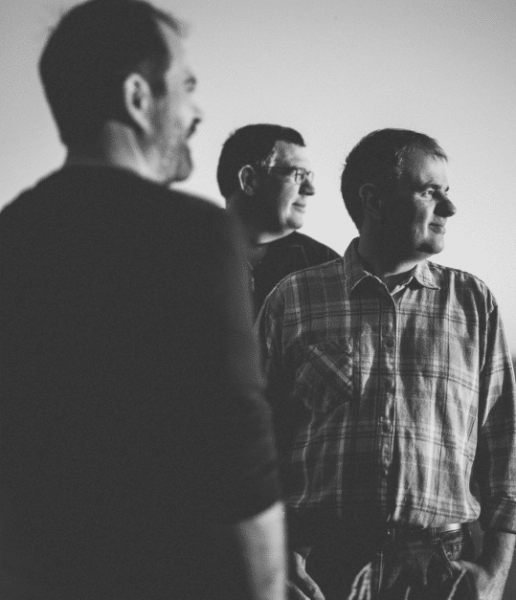Familie Reinisch
Started in 1923, Johanneshof Reinisch is a 40 Hectare estate, in the village of Tattendorf, located in Thermenregion. Thermenregion is “the end of the alps”, a DAC region in Austria, south and slightly west of Vienna. Today, the estate is run by the fourth generation of the family: the three Reinisch Brothers – Michael, Hannes, and Christian. The Johanneshof sits in a strikingly beautiful valley, in the “suburbs of Vienna”. This is a region with marked differences in climate and soil between valley floor and hillside vineyards, which rise over 350 meters above sea level. The holdings at the Johanneshof are split between two villages: Tattendorf, where the winery is located, is down in the valley, where soils are alluvial chalk with a loose soil structure, under a deep layer of humus and clay. The village of Gumpoldskirchen is up on the hillside, at a much higher elevation. The soils are fossil bearing limestone with less topsoil and lighter soil structure. Gumpoldskirchen is slightly cooler and windier. With its lighter, limestone dominated soils, the vineyards here planted to Pinot Noir, as well as Chardonnay, while the valley floor is home to Sankt Laurent and autochthonous varieties Zierfandler and Rotgipfler. Currently the brothers farm 15 hectares in Gumpoldskirchen and 25 in the village Tattendorf.
The Reinisch brothers converted to organic viticulture in 2004 and certified in 2010. This is a leading estate for red wine, widely considered to be the best in the region. When traveling in Austria and visiting various restaurants, you can be sure that if a wine from Thermenregion is listed, it will be from Johanneshof Reinisch. Currently, the brothers are working on conversion to Biodynamics but want to be very connected to the process, “not just doing the two sprays you need for certification” and so they are moving slowly, as they did for organic conversion. More than 50% of the estate is red wine, an even split between Pinot Noir and Sankt Laurent. These are some of the most striking red wines that we’ve tasted from Austria and offer a completely different and complimentary character to the excellent red wines we represent from Burgenland and Carnuntum, where Blaufränkisch and Zweigelt are the major players. It should be noted that Cistercian monks brought Pinot Noir (as well as Pinot Gris and Chardonnay) from Burgundy hundreds of years ago. In fact the monks of the Heiligenkreuz Abbey founded Freigut Thallern near Gumpoldskirchen in 1141, and built an enormous walled vineyard on the hills above the village, which stands today.
In the beautiful, vaulted cellars, Hannes Reinisch is responsible for the wines. For Pinot Noir, he uses French wood, mostly 225-500L barrels from 10 different coopers. For Sankt Laurent, Hannes employs a mixture of French and Austrian oak from Stockinger in larger sizes. The fermentations at the estate are either in big wooden fermenters or stainless-steel vats where Hannes can make any number of decisions depending on the site, variety, and vintage. For Pinot Noir, Hannes normally uses 30% whole cluster, but this is not set in stone. “In warmer vintages, we do more, in cooler years less, and some plots 100%. For Sankt Laurent it is normally between 10-30% whole cluster” he says. After fermentation, the wines are then pressed and then filled directly into casks for aging. The Pinot Noir comes from 15 different clones, from Romanee Conti and others in Burgundy, while the Chardonnay is Burgundian and Sankt Laurent is a mixture of old Austrian clones. For French oak, Hannes makes the point that there are regional differences between coopers: in Burgundy, the coopers expect that the wine is in oak for 14 months, Bordeaux they expect to have the wine for 22 months; this has a big effect on how the wood is treated. Hannes generally uses Burgundy barrels for Pinot Noir and Chardonnay, Bordeaux for Sankt Laurent. Normally, the barrels are used for five years before they are replaced, but the total amount of new wood is quite small.
Whenever we talk about “old-world” Pinot Noir, we immediately think of Burgundy. Tasted blind, Reinisch’s Sankt Laurent could easily be mistaken for Pinot Noir. While these wines have some kinship with Burgundy in terms of flavor, the texture and appeal of the wines are unique. They are not stand-ins for great Burgundy but are excellent wines with their own character, expressing their place clearly. Like all great wines of the world, there is nothing quite like them.
We are thrilled to be representing the delicious and unique wines of Johanneshof Reinisch, our first foray into this historical region!




